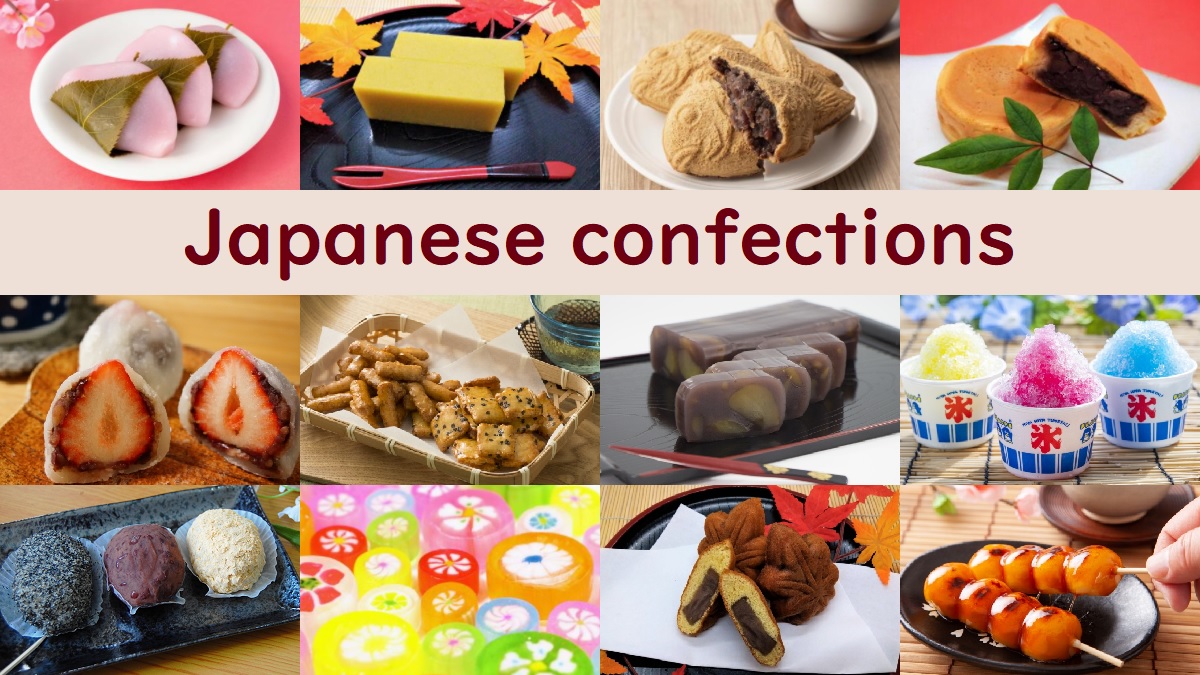Japanese confections
About Japanese confections
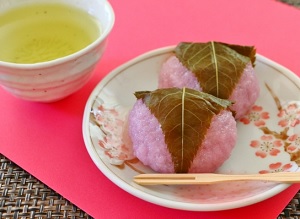
Many Japanese confectionery are sweet, because they are eaten with green tea.
And they are mainly made from only a few ingredients.
They are rice, wheat flour, azuki (small red bean) and sugar.
Especially, an made from beans is commonly used for many sweet confections.
(Sometimes, it is also called anko.)
"An" is the paste made by boiling beans with sugar.
So, it is very sweet.
"An" is used like jam or cream of Western confections.
It is used as the filling or coating of Japanese confections.
"An" made from adzuki bean (small red bean) is often used.
There are two types of adzuki an.
One is "tsubu-an" made with seed coat, and another is "koshi-an" made without seed coat.
Both are used, and the color is close to deep purple and brown.
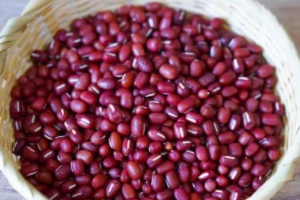
Adzuki beans to make 'an'
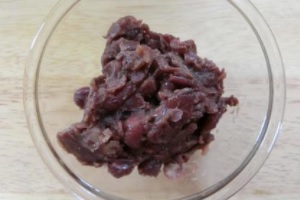
Tsubu-an
In addition, there is "an" mixed "koshi-an" with sweetly boiled large adzuki beans.
It is called "ogura-an", and the shape of adzuki beans is seen.
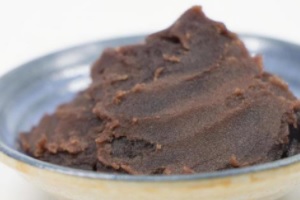
Koshi-an

Ogura-an
As the other "An", there are "shiro-an" (White an) made from white common beans and "uguisu-an" (Green an) made from green peas.
As above, Japanese confections use sugar, but doesn't use fat such as butter and cream.
Therefore, most Japanese confections have lower calories than Western confections.
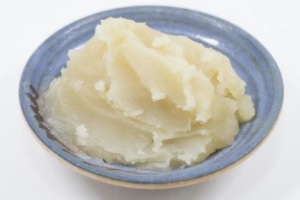
Shiro-an

Uguisu-an in Japanese cake
Confections like cookie or cracker
Senbei
Senbei is the generic name of confections like cookie or cracker.
Glutinous rice or wheat flour is used and it is made by baking over fire.
Some senbei are made by frying in oil.
Senbei from glutinous rice are generally brushed with a flavoring sauce made of shoyu and mirin, or are flavored with salt.
Some senbei are wrapped with a layer of nori.
These are sometimes called "okaki".
Of course, the senbei of this type doesn't have sweet taste.
On the other hand, senbei from wheat flour are usually mixed sugar and egg, so they have sweet taste.
It is similar to cookie, but the senbei of this type is generally crisper than cookie.
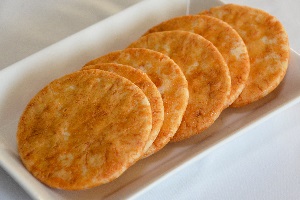
Senbei of shoyu taste
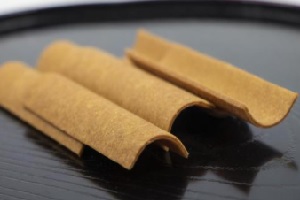
Sweet senbei 'Yatsuhashi' in Kyoto
Arare
Arare is a type of bite-sized senbei made from glutinous rice.
The size of Senbei is usually over 4 to 10 centimeters.
But, because arare is small, you can eat one after another.
Like senbei, shoyu or salt is mainly coated.
And some arares are colored.
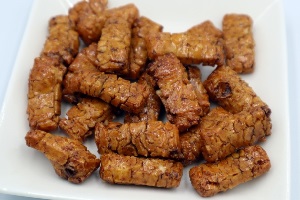
Arare of shoyu taste
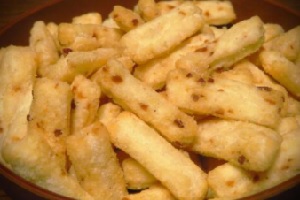
Arare of salt taste
Confections like cake
Manju
Manju is most popular Japanese confection.
"U" in the word is pronounced long, so it is read as "manjû".
Manju is made by wrapping "an" with a skin made of any flour and steaming it.
As the variety of the skin, brown sugar, miso, powder of green tea, etc. is mixed in it.
You can find them at souvenir shops in Japan.
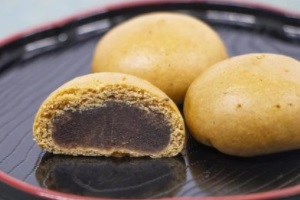
Manju
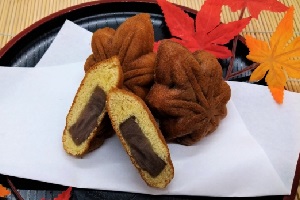
Momiji-manju in Hiroshima
Daifuku
Daifuku is also a confection like manju.
But, the outside is made of mochi and "an" is filled.
Generally all daifuku are covered in a fine layer of starch to keep them from sticking to each other, or to the fingers.
Recently, a Daifuku filling a whole strawberry with "an" is popular.
It is called "Ichigo-Daifuku".
Dorayaki
Dorayaki is the confection which consists of two small pancake-like patties made from flour, egg and sugar wrapped around a filling "an".
"Dora" means gong. It looks like gong.
By the way, it is Doraemon's favorite food.
("Doraemon" is the leading character of Japanese popular manga for children, and he is a robotic cat which came from the future.)
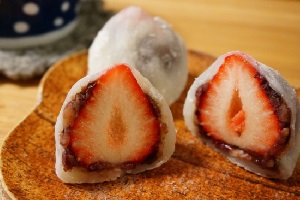
Ichigo-Daifuku
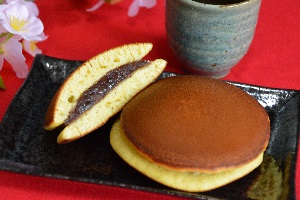
Dorayaki
Monaka
Monaka is the confection made of "an" filling sandwiched between two thin crisp wafers made from mochi.
Yokan
Yokan is a thick jellied dessert made of boiled adzuki beans, agar, and sugar.
"O" in the word is pronounced long, so it is read as "Yôkan".
It is usually sold in a block form, and eaten in slices.
It is very sweet confection.
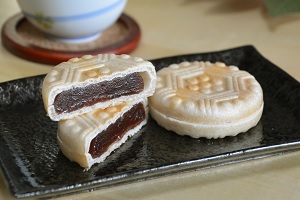
Monaka
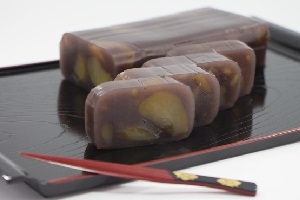
Yokan with chestnuts
Confections made at street stalls
The following confections are made and sold at street stalls and supermarkets.
You may try to taste them easily when you travel in Japan.
Taiyaki
It is a fish-shaped cake.
The batter from wheat flour is poured into a fish-shaped mould for each side.
And "tsubu-an" is put on one side and the mold is closed.
Then, it is cooked on both sides until golden brown.
The fish is "tai" (sea bream).
Of course, the cake doesn't include the fish.
In Japan, tai has a meaning of joyous fish. So the form is used for this cake.
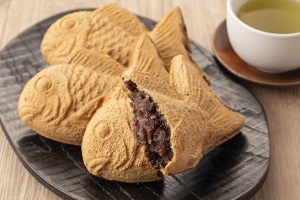
Taiyaki
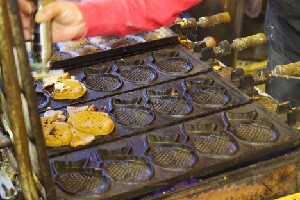
Making Taiyaki
Imagawayaki
It is a round cake.
The size is about 7 centimeters in diameter and about 2.5 centimeters thick.
The batter and the method of making is the same as Taiyaki.
But as the filling, not only "an" but also custard cream is used. You can choose them.
In some stands, it is called "Oobanyaki" or "Kaiten-yaki".
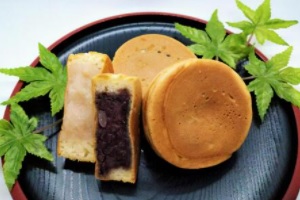
Imagawayaki
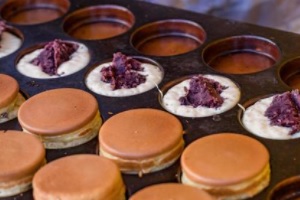
Making imagawayaki
Candy
Candy is called "ame" in Japanese.
The production method is the same as the other countries.
Of course, there are the candies with Japan-specific flavor and form.
In Japan, many stalls open around shrine and temple during the festival.
At that time, candy apple is popular. ("Ringo-ame" in Japanese)
It is an apple coated with melted candy and strawberry and some fruits are used recently.
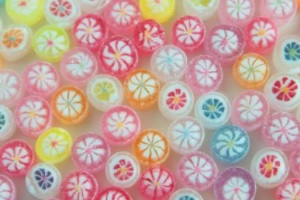
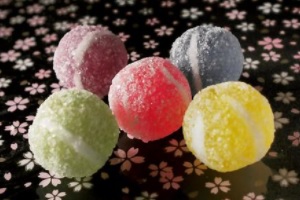
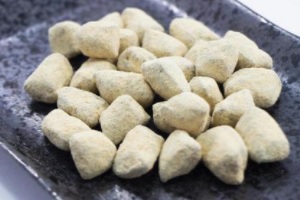
Traditional Japanese ame
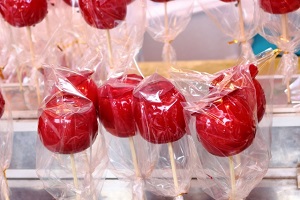
Ringo-ame sold in stall
Dango
Dango is the dumpling made from rice flour.
Generally, 3 to 5 dangos are often served on a skewer.
Plain dango is slightly sweet because a little sugar is added to the dumpling.
And there are many different varieties of dango that the various seasonings served on or with it.
Most popular seasonings are "an" and a syrup made from shoyu, sugar and starch.
The dango coated with the latter seasoning is called Mitarashi.
"Shiratama" is a dango made from special rice flour and is very smooth.
It is often put into the sweets in a bowl such as Anmitsu, Zenzai described later.
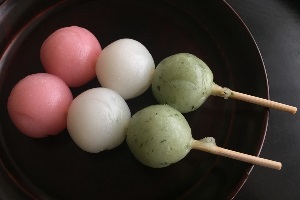
Tricolor Dango in cherry clossom season
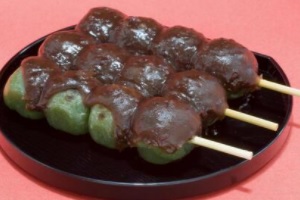
Yomogi (Mugwort) Dango with An
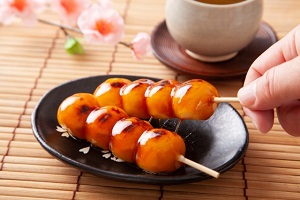
Mitarashi Dango
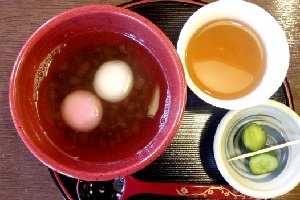
Shiratama Zenzai
Seasonal confectionery
Sakura-mochi
Sakura-mochi is made in spring.
Sakura is the cherry blossom tree which is the symbol of Japan in spring.
Sakura-mochi is made by wrapping "an" in pink mochi or glutinous rice.
Additionally, it is wrapped in a salted cherry leaf.
The cherry leaf is edible.
Of course, it is a little salty but has refreshing taste.
Kashiwa-mochi & Chimaki
May 5th is Children's Day, and it is a day to promote the happiness and well-being of children.
For this day, Kashiwa-mochi and Chimaki are made.
Kashiwa-mochi is made by wrapping "an" in white mochi (Rice cake).
Additionally it is wrapped in a leaf of "kashiwa oak".
Chimaki is a dango wrapped in some bamboo leaves.
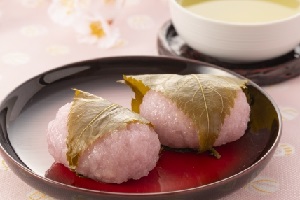
Sakura-mochi
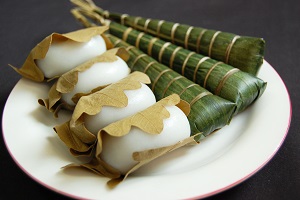
Kashiwa-mochi & Chimaki
Kuzu-mochi
Kuzu-mochi is a confection using the flour of "kuzu".
Kuzu is a plant called as arrowroot in English and grows in Eastern Asia.
The flour is made from the root, and kuzu has been used as an ingredient of Japanese sweets.
The flour and sugar is boiled in water, then it becomes like translucent and hard jelly.
Because of their cool appearance, it is used as the sweets in hot season.
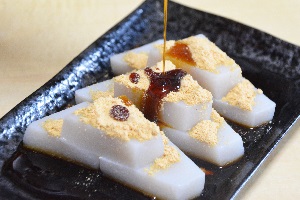
Kuzu-mochi with soybean flour
Brown syrup is poured
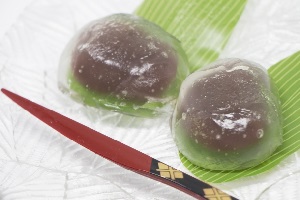
Kuzu-manju, An wrapped with kuzu
Mizu-yokan
Mizu-yokan is a kind of yokan made by adding more water than common yokan.
"Mizu" means water.
It is softer and lighter than yokan.
So it is eaten in summer.
Botamochi / Ohagi
Botamochi or Ohagi is the confection that thick "an" is hand-packed around pre-formed balls of rice.
And, botamochi / ohagi coated with Kinako (Powder of roasted soybesns) are often made.
Since old days, it was made at home when community festivals or Buddhist service.
The confection made for spring festival is "Botamochi" and one made for autumn festival is "Ohagi".
But, you can find it at any Japanese-style confection store.
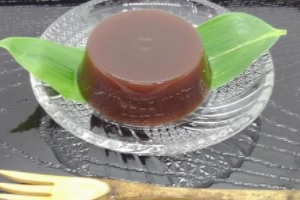
Mizu-yokan
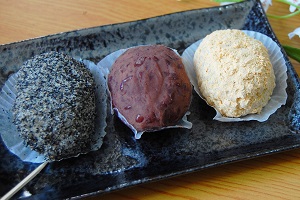
Botamochi (Ohagi)
Jo-namagashi
Jo-namagashi means high-class unbaked cake.
It is the confectionery made by using smooth and soft "an", mochi and other high-quality ingredients and using subtle craftsmanship.
Most of them are made colorfully and artistically and they look like artifacts.
These are served in Japanese tea ceremony and formal ceremony of any event.
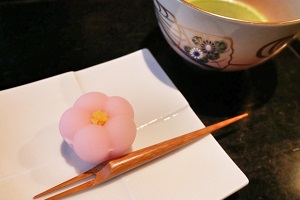
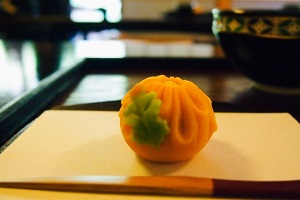
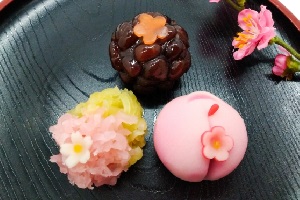
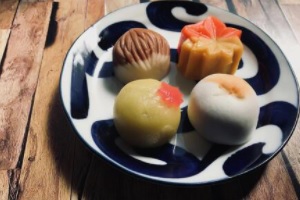
Confectionery served at cafe
Mitsumame, Anmitsu
Mitsumame and Anmitsu are popular desserts served in a bowl.
Mitsumame is a dessert with small cubes of agar, boiled peas and a variety of fruits such as peach slices, mikan, pieces of pineapple and cherries in syrup.
There is also a menu adding ice cream.
Anmitsu is a dessert that "an" is added on mitsumame.
Agar is a food made from the slime of seaweed and marine algae.
It is like jelly without taste and smell.
The syrup is usually served in a small pot, and you can pour onto the bowl before eating.
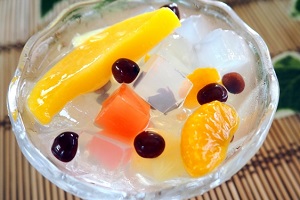
Mitsumame
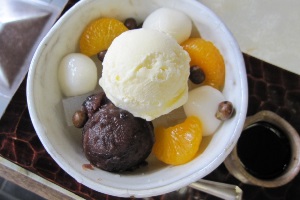
Anmitsu with ice cream
Zenzai, Shiruko
Zenzai is a dessert that azuki (small red beans) and sugar are brought to a simmer.
Commonly mochi, shiratama or chestnuts are put into it.
It is sweet and hot desert.
In Zenzai, azuki beans keep the original shape.
If azuki are turned into paste before cooking, it is called Shiruko, or politely Oshiruko.
It is like sweet azuki soup.
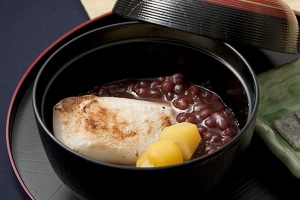
Zenzai
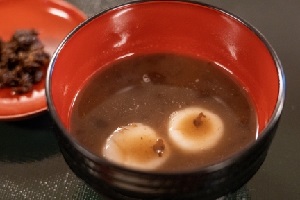
Oshiruko
Kakigori
Kakigori is a dessert made from shaved ice flavored with syrup.
Of course, it is served mainly in midsummer.
"O" in the word is pronounced long, so it is read as "kakigôri".
White shaved ice like fresh snow is heaped up in a bowl and colorful syrup is put on it.
Popular flavor syrup are strawberry (red color), lemon (yellow color), melon (green color) and blue-Hawaii (sky blue color and sweet-and-sour taste).
You can add on condensed milk to these flavor.
Popular Japanese flavors are Ogura ("an") and Uji-kintoki (green tea syrup and "an").
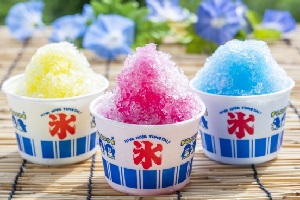
Kakigori of various syrup
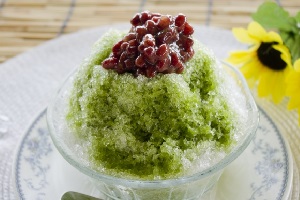
Kakigori of Uji-kintoki

